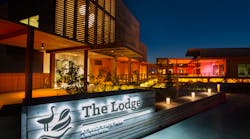The Waterfalls ranged from 90 to 120-feet tall and were on view from June 26 through October 13, 2008. The project was commissioned by the non-profit Public Art Fund in collaboration with the City of New York.
Each waterfall utilized a continuous row of assembled 5 feet sections of LED fixtures, supplied by Boca Flasher Inc, with a mixture of cool and warm white LEDs controlled by 3 separate channels. The total wattage was 300W per 5 ft. section at 100% output, while the actual operating load was 15-25%, depending on the site.
Light from the LED fixtures grazed the back of the water, penetrating the flow and accentuating the effect of wind gusts and changes in water flow rate. A custom baffle just below the LED source prevented glare at normal viewing angles.
The Lighting Designer for the project was Michael Mehl of Jaros, Baum & Bolles. “Working with LEDs offered us very interesting possibilities both technically and aesthetically in realizing Eliasson’s artistic vision,” he said.
Hiding the source was the biggest challenge, so that the water would appear as if lit by moonlight. “The size-to-light output ratio of the LEDs favored them over conventional lamp sources,” said Mehl. “We focused our design attention on the caveats of the technology, such as lamp-to-lamp color consistency and optics.”
The designer also believes that a critical component to using LEDs, beyond the specific source, is the choice of manufacturer. “Architects and lighting designers should choose a manufacturer who understands the technology and can aide the design process considerably. Since LEDs are a compilation of components, the best friend the lighting consultant can have with the burgeoning technology is to work with a manufacturer who understand the nuances of LEDs and can integrate ever-evolving aspects of the technology, while delivering on the conventional design process of conception through installation.”








